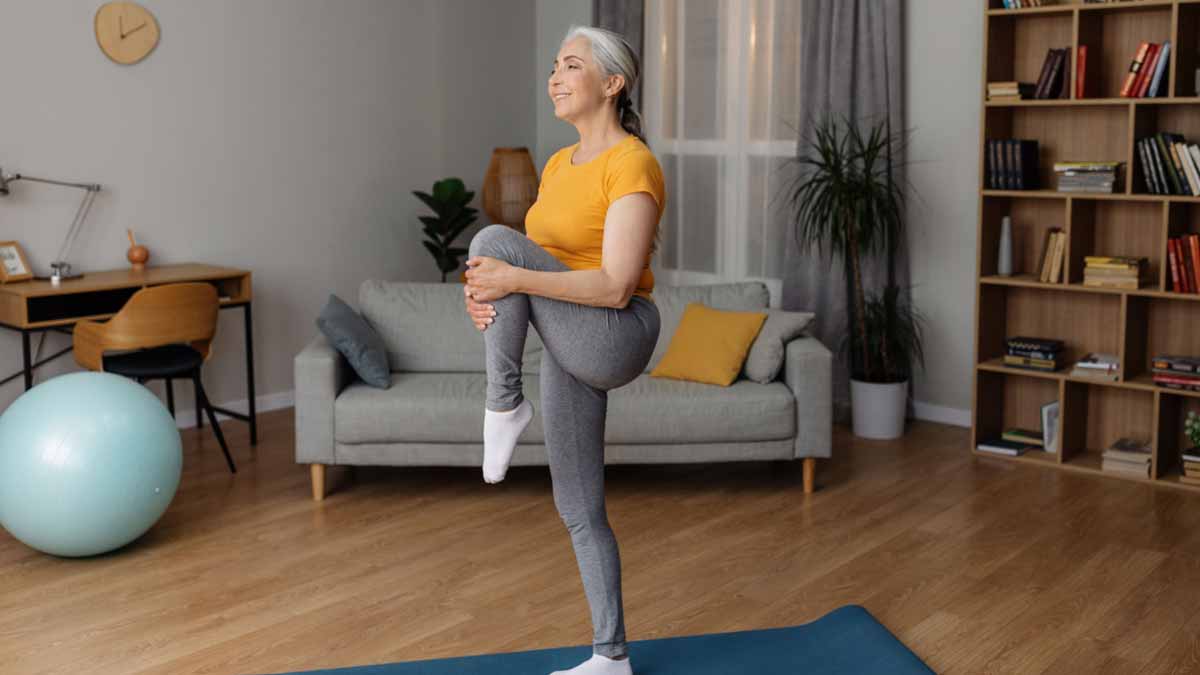Some mornings, courage looks like standing tall beside a chair and taking the first steady step. I train older adults every week, and I’ve watched balance return with patience and small, repeatable moves. Joints stay calm, posture lifts, and walking feels easier. You don’t need fancy gear, just a safe setup and clear cues. With gentle exercises, we build strength you can use in daily life. We keep it simple, we go slow, and we let confidence grow one clean rep at a time.
Why balance training matters long before a fall
Start balance work early, ideally in your forties, because the nervous system adapts with practice. Unilateral drills challenge each side separately, so hips, knees, and ankles learn to stabilize without help from the other leg. Alongside skill, basic core training steadies the trunk so reactions stay quick when footing shifts.
For equipment, use a sturdy chair or counter, plus light dumbbells you can press overhead with clean form. Wobble boards or cushions add instability when you are ready, but flat ground comes first. Safety beats speed, so move slowly, breathe evenly. And pause whenever posture fades or the chair starts to carry weight.
Here is the structure I program for older clients: three rounds, eight to ten repetitions per movement, resting as needed between sets. Perform one side fully before switching on single-leg tasks. This routine builds coordination while keeping intensity low, because the goal is reliable balance, not exhaustion from these exercises.
How this session runs, from warm-up to cool-down with exercises
Begin behind your chair for the back leg raise. Stand tall, keep knees straight, and glide the right leg backward without pointing the toes; hold briefly, then lower with control. Complete all reps on one side before the other. Next, the flamingo stand: lift one knee and the opposite arm, hold fifteen seconds per leg, trunk upright.
Continue with the leg swing. Stand side-on to the chair; with feet hip-width apart, hover the outside foot and sweep it left to right for eight to ten reps, setting it down between reps if needed. These standing patterns sharpen ankle strategy, encourage hip stability, and tune quick reactions when ground feels uncertain.
Programming tips make practice stick: choose a stable chair, clear floors, and good lighting. Train three nonconsecutive days each week so tissues recover while skills consolidate. Track small wins such as longer holds or smoother hinges; that simple record keeps motivation high and anchors habit around these exercises each week.
Standing moves that teach control one step at a time
Sit tall for running-man arms. Hold a light dumbbell at the right shoulder and the left by your hip, then switch smoothly so the weights trade places; repeat for eight to ten repetitions. This rhythmic swing coordinates shoulders and trunk while you keep ribs down and feet planted for solid support throughout.
Next, the seated overhead press for eight to ten reps. Start with dumbbells near shoulders, press to full extension without shrugging, then lower under control. If challenging, press one arm at a time or practice the motion unweighted. Clean alignment matters more than load when balance is the priority.
Finish the upper-body block with the seated alternate front raise. From thighs, lift one arm to chest height, then lower before switching sides. Think smooth tempo, even breathing, steady gaze, and relaxed grip; the shoulder girdle works while your core resists sway, translating strength into steadier walking from these exercises.
Seated strength that supports shoulders, arms, and core with exercises
Seated side crunch develops lateral stability that prevents tipping when a bus lurches or a curb surprises you. Hold dumbbells outside the thighs, slide one weight toward the floor, keep the back against the chair, then return to center before switching. Perform eight to ten reps each side, focusing on ribs gliding over the pelvis instead of leaning forward.
Blend standing and seated pieces into one circuit so heart rate stays comfortable and recovery feels smooth. Use a minute of easy marching between sets for rhythm. Balance improves with variety: mix static holds, slow swings, and controlled reaches so the body learns options and confidence grows under gentle challenge.
Progress gradually. First, reduce hand support from two hands to fingertips to hovering. Later, lengthen flamingo holds, add a thicker cushion, or raise lighter weights more slowly; consistent, careful increments deliver durable gains from these exercises without risking form, breathing rhythm, or joint comfort during steady, attentive practice every week.
Progression, weekly structure, and simple ways to stay consistent
Keep sessions simple with a weekly template you can repeat. For example: Monday focuses on standing control, Wednesday blends upper-body strength with seated core, Friday repeats the full circuit. Log cues that helped—‘taller chest,’ ‘soft knees,’ ‘quiet feet’—because consistent self-coaching turns cautious steps into smooth, everyday movement that feels natural.
Respect signals. If back pain, dizziness, or foot numbness appears, stop and consult a clinician who knows your history. Use supportive shoes, clear space, and a chair that does not slide. Friends or family can spot you during new drills, since another set of eyes keeps alignment tidy and focus calm.
Pair practice with life. Brush teeth while standing on one leg near the sink, perform three chair presses during TV ads, or hold a flamingo before meals. Small habit loops multiply exposure, rewiring balance with little strain; that steady repetition locks in results from these exercises over patient, consistent months.
A steady routine turns small daily choices into lasting strength and calm balance
Stay patient and curious. Use light loads, crisp posture, and a reliable chair so form leads every rep. Complete three rounds, eight to ten repetitions, and rest whenever focus fades. With practice, these carefully layered exercises amplify stability, protect joints, and support confident movement during chores, strolls, and surprise stumbles. Keep notes, celebrate tiny wins, and nudge difficulty slowly; those habits build durable balance you can rely on day after day.
